A Review of Icing and Anti-Icing Technology for Transmission Lines
Abstract
:1. Introduction
2. The Failure Classification of Icing Lines
2.1. Mechanical Overloading
2.2. Uneven Icing or De-Icing at Different Times
2.3. Ice-Covered Conductors Galloping
2.4. Icing Flashover of Insulator
3. Formation and Influencing Factors of Icing
3.1. Formation of Icing
3.2. Classification of Icing
3.2.1. Hoar Frost
3.2.2. Rime
3.2.3. Mixed Rime
3.2.4. Glaze
3.2.5. Snow
3.3. Influence Factor of Icing
3.3.1. Meteorological Conditions
3.3.2. Geographical and Topography
3.3.3. Altitude
3.3.4. Transmission Lines Direction and Suspension Height
3.3.5. Shape and Size
3.3.6. Influence of Electric Field
4. Anti/De-Icing Technology of Conductors
4.1. Mechanical De-Icing
4.1.1. Manual Deicing by Striking
4.1.2. Icing Rolling
4.1.3. Blasting De-Icing
4.1.4. Electromagnetic Vibration De-Icing
4.1.5. Robot De-Icing
4.2. Short Circuit Ice Melting
4.2.1. Basic Parameters of Short Circuit Ice Melting
- The critical load current of icing
- 2.
- Critical ice melting current
4.2.2. AC Short-Circuit Ice Melting
- Three phases short-circuit ice melting
- 2.
- Two phases short-circuit ice melting
- 3.
- Single phases short-circuit ice melting
4.2.3. DC Short-Circuit Ice Melting
- Melting ice for DC line
- 2.
- Melting ice for AC line
4.3. Corona Discharge Effect
4.4. Torque Pendulum
4.5. Expanded the Diameter Conductor to Replace Bundled Conductors
4.6. CTIIMD
5. Anti/De-Icing Technology of Insulator
5.1. Application of Hydrophobic Materials
5.2. Heating Coating
5.3. Optimization of the Shed Structure
5.4. String Arrangement
6. Conclusions
Author Contributions
Funding
Institutional Review Board Statement
Informed Consent Statement
Data Availability Statement
Conflicts of Interest
References
- Imai, I. Studies on Ice Accretion. Res. Snow Ice 1953, 1, 35–44. [Google Scholar]
- Farzaneh, M.; Chisholm, W.A. Insulators for Icing and Polluted Environments; John Wiley & Sons: Hoboken, NJ, USA, 2009. [Google Scholar]
- Barat, A.; Guo, Q.; Fan, F.; Guo, X.; Zhang, Q. Analysis and Design of Transmission Line Icing Monitoring System Based on Optical Fiber Sensing. In Proceedings of the 2022 IEEE 10th Joint International Information Technology and Artificial Intelligence Conference (ITAIC), Chongqing, China, 17–19 June 2022; pp. 1846–1849. [Google Scholar] [CrossRef]
- Richardson, A. Dynamic analysis of lightly iced conductor galloping in two degrees of freedom. Generation, Transmission and Distribution. IEE Proc. C 1981, 128, 211–218. [Google Scholar]
- Morgan, V.; Swift, D.A. Effect of ice loads on overhead-line conductors. Electron. Power 1965, 11, 22–23. [Google Scholar] [CrossRef]
- Makkonen, L. Estimation of wet snow accretion on structures. Cold Reg. Sci. Technol. 1989, 17, 83–88. [Google Scholar] [CrossRef]
- Ihara, S.; Yamabe, C.; Ushio, S. Breaking of ice using pulsed power. In Proceedings of the Conference Record of the 2006 Twenty-Seventh International Power Modulator Symposium, Arlington, VA, USA, 14–18 May 2006; p. 342. [Google Scholar]
- Baliberdin, L.; Kozlova, M.; Shershnev, Y. Model group of controlled installation for melting ice on transmission line conductors. In Proceedings of the 2005 IEEE Russia Power Tech, St. Petersburg, Russia, 27–30 June 2005; pp. 1–5. [Google Scholar]
- Kannus, K.; Lahti, K. Laboratory Investigations of the Electrical Performance of Ice-covered Insulators and a Metal Oxide Surge Arrester. IEEE Trans. Dielectr. Electr. Insul. 2007, 14, 1357–1372. [Google Scholar] [CrossRef]
- Yang, J.; Li, Z.; Yang, F.; Huang, T. Analysis on the characteristics of ice-covered power grid disaster and tower toppling in 2008. Adv. Power Grids Hydropower 2008, 4, 4–8. (In Chinese) [Google Scholar]
- Dong, B.; Jiang, X.; Yin, F. Development and prospect of monitoring and prevention methods of icing disaster in China power grid. IET Gener. Transm. Distrib. 2022, 16, 4480–4493. [Google Scholar] [CrossRef]
- Zhou, X.; Zhu, Y.; Zhang, Y.; Li, H. A Review of Anti-icing and De-icing Technology of Overhead Ground Wire. In Proceedings of the 2022 International Symposium on Electrical. Electronics and Information Engineering (ISEEIE), Chiang Mai, Thailand, 25–27 February 2022; pp. 282–286. [Google Scholar] [CrossRef]
- Peng, S.; Hao, W.; Zhai, Y. Review of the research on icing mechanism of transmission lines and ice-melting technologies. In Proceedings of the 2015 5th International Conference on Electric Utility Deregulation and Restructuring and Power Technologies (DRPT), Changsha, China, 26–29 November 2015; pp. 1648–1652. [Google Scholar] [CrossRef]
- Yan, X.; Yuebin, Z.; Guobang, B.; Wanyu, C.; Liuqing, Y.; Wenyong, Y.; Qiansu, L.; Ronghua, Z.; Shukai, X.; Chuang, F. Research on MMC de-icing system capable of power grid interconnection. In Proceedings of the 2021 Annual Meeting of CSEE Study Committee of HVDC and Power Electronics (HVDC 2021), Beijing, China, 28–30 December 2021; pp. 29–38. [Google Scholar] [CrossRef]
- Liu, Y.; Farzaneh, M.; Du, B. Investigation on shed icicle characteristics and induced surface discharges along a suspension insulator string during ice accretion. IET Gener. Transm. Distrib. 2017, 11, 1265–1269. [Google Scholar] [CrossRef]
- Guo, J.; Li, J.; Rong, C.; Dong, Z.; Guan, W.; Zheng, Y.; Tan, L. Effectiveness Evaluation System and Evaluation Method for Anti-ice Damage Technical Transformation Project of Overhead Lines. In Proceedings of the 2019 IEEE 3rd International Electrical and Energy Conference (CIEEC), Beijing, China, 7–9 September 2019; pp. 314–319. [Google Scholar] [CrossRef]
- Yan, X.; Li, J.; Li, L.; Huang, Z.; Hu, J.; Lu, M. An OH-PDMS-modified nano-silica/carbon hybrid coating for anti-icing of insulators part II: Anti-icing performance. IEEE Trans. Dielectr. Electr. Insul. 2016, 23, 2165–2173. [Google Scholar] [CrossRef]
- Zhu, Y.; Tan, Y.; Huang, Q.; Huang, F.; Zhu, S.; Mao, X. Research on Melting and De-icing Methods of Lines in Distribution Network. In Proceedings of the 2019 IEEE 3rd Conference on Energy Internet and Energy System Integration (EI2), Changsha, China, 8–10 November 2019; pp. 2370–2373. [Google Scholar] [CrossRef]
- Liu, C.; Qin, J.; Hao, Y.; Li, G.; Chen, Y. Research on Verification Test of Tension Stringing for UHV Transmission Line Project. In Proceedings of the 2020 IEEE Sustainable Power and Energy Conference (iSPEC), Chengdu, China, 23–25 November 2020; pp. 1766–1771. [Google Scholar] [CrossRef]
- Xie, D.; Song, W.; Wang, W.; Sun, T.; Huang, T.; Cai, X. Research on ice removal blasting parameters of HV Transmission Lines. J. North Univ. China 2018, 39, 746–751. (In Chinese) [Google Scholar]
- Cao, Y.; Xue, K.; Miao, L.; Li, H.; Guan, X.; Zhang, J.; Li, G. Dynamic response analysis of ice tower line system after blasting deicing. J. North Univ. China: Nat. Sci. Ed. 2019, 040, 198–205. (In Chinese) [Google Scholar]
- Zumw, A.; Muwller, A. Flight and Wind Tunnel Tests of an Electro-Ipulse De-icing System. In Proceedings of the AIAA /NASA General Aviation Technology Conference, Hampton, VA, USA, 10–12 July 1984; pp. 10–12. [Google Scholar]
- Jiang, X.; Chen, Y.; Huang, T.; Wang, M.; Huang, H. Electro-impulse de-icing (EIDI) test of aircraft wing leading edge. In Proceedings of the 22nd International Symposium on High Voltage Engineering (ISH 2021), Xi’an, China, 21–26 November 2021; pp. 66–71. [Google Scholar] [CrossRef]
- Landry, M.; Beauchemin, R.; Venne, A. De-icing EHV overhead transmission lines using electromagnetic forcess generated by moderate short-circuit current. C. In Proceedings of IEEE 9th International Conference on Transmission and Distribution Construction, Operation and Live-line Maintenance, Montreal, QC, Canada, 8–12 October 2000; pp. 94–100. [Google Scholar]
- Montambault, S.; Pouliot, N. The HQ LineROVer: Contributing to innovation in transmission line maintenance. In Proceedings of the 2003 IEEE 10th International Conference on Transmission and Distribution Construction, Operation and Live-Line Maintenance, Orlando, Orlando, FL, USA, 6–10 April 2003; pp. 33–40. [Google Scholar]
- Zhao, J.; Guo, R.; Cao, L.; Zhang, F. Improvement of LineROVer: A mobile robot for de-icing of transmission lines. In Proceedings of the 2010 1st International Conference on Applied Robotics for the Power Industry, Montreal, QC, Canada, 5–7 October 2010; pp. 1–4. [Google Scholar]
- Li, K.; Du, L.; Han, W. Icing Analysis of Transmission Lines Considering the Current Heat. In Proceedings of the 2011 Asia-Pacific Power and Energy Engineering Conference, Wuhan, China, 25–28 March 2011; pp. 1–4. [Google Scholar] [CrossRef]
- Sun, C.; Jiang, X.; Xiong, Q.; Yi, H. Analysis of Critical Conditions for Ice Coating and Dry-Wet Growth of Conductors. Proc. CSEE 2003, 3, 141–145. (In Chinese) [Google Scholar]
- Jiang, X.; Fan, S.; Zhang, Z.; Sun, C.; Shu, L. Simulation and Experimental Investigation of DC Ice-Melting Process on an Iced Conductor. IEEE Trans. Power Deliv. 2010, 25, 919–929. [Google Scholar] [CrossRef]
- Jiang, X.; Fan, S.; Hu, J.; Zhang, Z.; Sun, C. Critical Current Analysis of DC Short-circuit Ice Melting in Transmission Lines. Proc. CSEE 2010, 30, 111–116. (In Chinese) [Google Scholar]
- Shu, L.; Luo, B.; Jiang, X.; Hu, Q.; Li, T.; Lan, Q. Intelligent loop current critical melting ice thawing method and its current research. J. Electrotech. 2012, 27, 26–34. (In Chinese) [Google Scholar]
- Yin, F.; Farzaneh, M.; Jiang, X. Corona investigation of an energized conductor under various weather conditions. IEEE Trans. Dielectr. Electr. Insul. 2017, 24, 462–470. [Google Scholar] [CrossRef]
- Yin, F.; Farzaneh, M.; Jiang, X. Influence of AC electric field on conductor icing. IEEE Trans. Dielectr. Electr. Insul. 2016, 23, 2134–2144. [Google Scholar] [CrossRef]
- Huang, Y.; Jiang, X.; Hou, L.; Zhu, M.; Han, X. Experimental Study on Reducing Icing on Conductor Using Self-heating Ring. In Proceedings of the 2018 IEEE International Conference on High Voltage Engineering and Application (ICHVE), Athens, Greece, 10–13 September 2018; pp. 1–4. [Google Scholar] [CrossRef]
- Yin, F.; Farzaneh, M.; Jiang, X. Laboratory investigation of AC corona loss and corona onset voltage on a conductor under icing conditions. IEEE Trans. Dielectr. Electr. Insul. 2016, 23, 1862–1871. [Google Scholar] [CrossRef]
- Zhang, Z.; Jiang, X.; Liu, J.; Lei, Y.; Li, R.; Fu, H. Distributed Hanging Weight Arrangement Method for Restraining Torsion and Dancing of Conductor. Patent CN112332353B, 21 December 2021. (In Chinese). [Google Scholar]
- Desai, Y.; Yu, P.; Popplewell, N. Perturbation-based finite element analysis of transmission line galloping. Sound Vibr. 1996, 191, 469–489. [Google Scholar] [CrossRef] [Green Version]
- Florea, G.; Florea, M.; Tibuliac, S.; Vaju, M.; Oltean, M.; Mateescu, E. Upgrading the Romanian 400 kV lines with 2 and 3 subconductors per phase to reduce the risk of galloping occurance and the galloping amplitudes by the installation of torsional dampers and detuners, live-line procedures. In Proceedings of the 2016 IEEE PES 13th International Conference on Transmission & Distribution Construction, Operation & Live-Line Maintenance (ESMO), Columbus, OH, USA, 12–15 September 2016; pp. 1–5. [Google Scholar] [CrossRef]
- Wang, X.; Yu, J.; Liu, Z.; Qin, Z.; Jiang, X.; Hu, Q. Comparison of Icing on Equivalent DEC and Bundled Conductors. High VOLTAGE Technol. 2022, 48, 2698–2705. (In Chinese) [Google Scholar] [CrossRef]
- He, J.; Li, X. Application Analysis of Expanded Conductor in 1000kV UHV Double-Circuit Line. AMM 2014, 664, 318–325. [Google Scholar] [CrossRef]
- Si, J.; Zhu, K.J.; Wan, J.C.; Yang, J.L.; Liu, L.; Ding, Y. Parametric Study on Simulation Modeling of DEC. In Advanced Materials Research; Trans Tech Publications, Ltd.: Bäch, Switzerland, 2013; Volume 815, pp. 69–72. [Google Scholar] [CrossRef]
- Jiang, X.; Fan, C.; Xie, Y. New method of preventing ice disaster in power grid using expanded conductors in heavy icing area. IET Gener. Transm. Distrib. 2019, 13, 536–542. [Google Scholar] [CrossRef]
- Bi, C.; Jiang, X.; Han, X.; Yang, Z.; Ren, X. Anti-icing Method Using Expanded Wire instead of Split Wire. Trans. China Electrotech. Soc. 2020, 35, 2469–2477. (In Chinese) [Google Scholar] [CrossRef]
- Huneault, M.; Langheit, C.; St-Arnaud, R.; Benny, J.; Audet, J.; Richard, J.-C. A dynamic programming methodology to develop de-icing strategies during ice storms by channeling load currents in transmission networks. IEEE Trans. Power Deli. 2005, 20, 1604–1610. [Google Scholar] [CrossRef]
- Jiang, X.; Wang, Y.; Shu, L.; Zhang, Z.; Hu, Q.; Wang, Q. Control scheme of the de-icing method by the transferred current of bundled conductors and its key parameters. IET Gener. Transm. Distrib. 2015, 9, 2198–2205. [Google Scholar] [CrossRef]
- Meng, Z.; Wang, Y.; Jiang, X.; Fan, S. Asynchronism of ice shedding from the de-iced conductor based on heat transfer. IET Sci. Meas. Technol. 2016, 10, 389–395. [Google Scholar]
- Hu, J.; Lan, B.; Xu, K.; Jiang, X.; Zhang, Z.; Shi, B.; Yang, H.; Wu, Y. Artificial icing and AC flashover tests on glass insulators with silicone acrylate resin hydrophobic coatings. IEEE Trans. Dielectr. Electr. Insul. 2016, 23, 1038–1047. [Google Scholar] [CrossRef]
- Li, X.; Yang, B.; Zhang, Y.; Gu, G.; Li, M.; Mao, L. A study on superhydrophobic coating in anti-icing of glass/porcelain insulator. Sol-Gel Sci. Technol. 2014, 69, 441–447. [Google Scholar] [CrossRef]
- Liao, W.; Jia, Z.; Guan, Z.; Wang, L.; Yang, J.; Fan, J.; Su, Z.; Zhou, J. Reducing Ice Accumulation on Insulators by Applying Semiconducting RTV Silicone Coating. IEEE Trans. Dielectr. Electr. Insul. 2007, 14, 1446–1454. [Google Scholar] [CrossRef]
- Zhao, Z.; Chen, H. Development of high-efficient synthetic electric heating coating for anti-icing/de-icing. Surf. Coat. Technol. 2018, 349, 340–346. [Google Scholar] [CrossRef]
- Sun, Z.; Jia, Z.; Wei, X.; Guan, Z. Optimization of Anti-icing Structure of Insulators Partially Coated with Semi-conductive Coating. Proc. CSEE 2012, 32, 132–138+201. (In Chinese) [Google Scholar] [CrossRef]
- Yin, F.; Jiang, X.; Farzaneh, M.; Hu, J. Electrical performance of 330-kV composite insulators with different shed configurations under icing conditions. IEEE Trans. Dielectr. Electr. Insul. 2015, 22, 3395–3404. [Google Scholar] [CrossRef]
- Lan, S. Study on the Anti-Icing Effect of Composite Insulator Coated with Photoelectric Mixed Coating; Chongqing University: Chongqing, China, 2019; (In Chinese). [Google Scholar] [CrossRef]
- Farzaneh, M.; Zhang, J.; Volat, C. Effect of insulator diameter on AC flashover voltage of an ice-covered insulator string. IEEE Trans. Dielectr. Electr. Insul. 2006, 13, 264–271. [Google Scholar] [CrossRef]
- Huang, Y.; Jiang, X.; Virk, M. Ice accretion study of FXBW4-220 transmission line composite insulators and anti-icing geometry optimization. Electr. Power Syst. Res. 2021, 194, 107089. [Google Scholar] [CrossRef]
- Hu, Q.; Wang, S.; Shu, L.; Jiang, X.; Qiu, G.; Li, H. Influence of shed configuration on icing characteristics and flashover performance of 220 kV composite insulators. IEEE Trans. Dielectr. Electr. Insul. 2016, 23, 319–330. [Google Scholar] [CrossRef]
- Hu, Q.; Wang, S.; Shu, L.; Jiang, X.; Liang, J.; Qiu, G. Comparison of AC icing flashover performances of 220 kV composite insulators with different shed configurations. IEEE Trans. Dielectr. Electr. Insul. 2016, 23, 995–1004. [Google Scholar] [CrossRef]
- Zhang, Z.; Jiang, X.; Sun, C.; Hu, J.; Huang, H.; Gao, D. Influence of insulator string positioning on AC icing flashover performance. IEEE Trans. Dielectr. Electr. Insul. 2012, 19, 1335–1343. [Google Scholar] [CrossRef]
- Jiang, X.; Zhao, S.; Hu, J.; Zhang, Z.; Shu, L. Study of DC flashover performance of ice-covered insulators at high altitude. IEEE Trans. Dielectr. Electr. Insul. 2013, 20, 391–400. [Google Scholar] [CrossRef]
- Xu, J.; Yin, F.; Li, L.; Wen, Q.; Wang, H.; Liu, S.; Jia, Z.; Farzaneh, M. Wet Snow Flashover Characteristics of 500-kV AC Insulator Strings with Different Arrangements. Appl. Sci. 2019, 9, 930. [Google Scholar] [CrossRef] [Green Version]
- Huang, Y.; Jiang, X.; Virk, M. Study of inverted T-shape insulator strings in icing conditions. Cold Reg. Sci. Technol. 2020, 173, 103021. [Google Scholar] [CrossRef]
- Jiang, X.; Yi, H. Transmission Line Icing and Protection; China Electric Power Publisher: Beijing, China, 2002. (In Chinese) [Google Scholar]
- Lu, J.; Guo, J.; Jian, Z.; Yang, Y.; Tang, W. Dynamic Assessment of Resilience of Power Transmission Systems in Ice Disasters. In Proceedings of the 2018 International Conference on Power System Technology (POWERCON), Guangzhou, China, 6–8 November 2018; pp. 7–13. [Google Scholar] [CrossRef]
- Runhua, W. Analysis of the accident based on low temperature, snowstorm, ice, coagulation. In Proceedings of the 2008 China International Conference on Electricity Distribution, Guangzhou, China, 10–13 December 2008; pp. 1–7. [Google Scholar] [CrossRef]
- Kunpeng, J.; Jingshan, H.; Jialun, Y.; Bin, Z.; Jian, W.; Bin, L.; Xueping, Z.; Lichun, Z. Dynamic analysis and suppression method of bundled conductors following ice shedding. In Proceedings of the 2021 IEEE Sustainable Power and Energy Conference (iSPEC), Nanjing, China, 23–25 December 2021; pp. 1596–1601. [Google Scholar] [CrossRef]
- Hu, J.; Yan, B.; Zhou, S.; Zhang, H.; Li, H.; Miao, C. Parameter Study on Galloping of Iced Bundled Conductors. In Proceedings of the 2010 Asia-Pacific Power and Energy Engineering Conference, Chengdu, China, 28–31 March 2010; pp. 1–4. [Google Scholar] [CrossRef]
- Lu, J.; Wang, Q.; Wang, L.; Yang, L.; Xu, X.; Li, L. Research on galloping and insulation characteristics of 500kV crescent-shaped iced quad bundle conductor. In Proceedings of the 2018 12th International Conference on the Properties and Applications of Dielectric Materials (ICPADM), Xi’an, China, 20–24 May 2018; pp. 941–947. [Google Scholar] [CrossRef]
- Wu, D.; Cao, H.; Li, D.; Yang, S. Energy-Efficient Reconstruction Method for Transmission Lines Galloping with Conditional Generative Adversarial Network. IEEE Access 2020, 8, 17310–17319. [Google Scholar] [CrossRef]
- Akagi, Y.; Koyama, S.; Ohta, H.; Nishizawa, H.; Nagata, Y.; Oka, T. Development of anti-galloping device for UHV transmission line. IEEE/PES Transm. Distrib. Conf. Exhib. 2002, 3, 2158–2161. [Google Scholar] [CrossRef]
- Huang, Q.; Tan, Y.; Mao, X.; Zhu, S.; Zhou, X. Study on Melting Ice Current Characteristics under Low Temperature and High Wind Speed. In Proceedings of the 2021 IEEE 5th Conference on Energy Internet and Energy System Integration (EI2), Taiyuan, China, 22–24 October 2021; pp. 4382–4385. [Google Scholar] [CrossRef]
- Cigre, T. Influence of ice and snow on the flashover performance of outdoor insulators, part I: Effects of snow. Electra 2000, 188, 55–69. [Google Scholar]
- Lu, J.; Zeng, M.; Zeng, X.; Fang, Z.; Yuan, J. Analysis of Ice-Covering Characteristics of China Hunan Power Grid. IEEE Trans. Ind. Appl. 2015, 51, 1997–2002. [Google Scholar] [CrossRef]
- Juan, W.; Chuang, F.; Yiping, C.; Hong, R.; Shukai, X.; Tao, Y.; Licheng, L. Research and Application of DC De–Icing Technology in China Southern Power Grid. IEEE Trans. Power Deliv. 2012, 27, 1234–1242. [Google Scholar] [CrossRef]
- Guo-te, L.; Yan-peng, H.; Yan, C. A comparative study of icing mechanism between soft rime and hard rime for the operating insulators. In Proceedings of the IEEE Annual Report Conference on Electrical Insulation and Dielectric Phenomena (CEIDP), Chenzhen, China, 20–23 October 2013; pp. 374–377. [Google Scholar]
- Jiang, X.; Xiao, D. Analysis of the Physical Process of Conductor Surface Icing. In Proceedings of the 2010 Academic Conference of Chongqing Society of Electrical Engineering, Chongqing, China, 29 October 2010; p. 89. (In Chinese). [Google Scholar]
- Zhang, Z.; Zhang, D.; Huang, H.; Jiang, X.; Gao, D. Study of the icing growth characteristic and its influencing factors for different types of insulators. Turk. J. Electr. Eng. Comput. Sci. 2016, 24, 63. [Google Scholar] [CrossRef]
- Zhuang, W.; Zhang, L.; Yang, Y. Research on Ice Accumulation of Transmission Lines in Xinjiang. In Proceedings of the 2022 Power System and Green Energy Conference (PSGEC), Shanghai, China, 25–27 August 2022; pp. 1012–1015. [Google Scholar] [CrossRef]
- Yiwei, X.; Yanpeng, H. Research of morphology of soft rime on suspension insulator for transmission line. In Proceedings of the 2013 Annual Report Conference on Electrical Insulation and Dielectric Phenomena, Chenzhen, China, 20–23 October 2013; pp. 319–322. [Google Scholar] [CrossRef]
- Bin, F.L.G.; Rong, Z.F.; Gang, L.; Hong, Y.; Chao, Q.G.; Liangchi, S.; En, Y.; Xiang, L. A Research of Drawing and Application of Distribution Diagram of Yunnan Ice Region Based on the Typical Ice Model of Low Latitude Plateau Area. In Proceedings of the 2018 International Conference on Power System Technology (POWERCON), Guangzhou, China, 6–8 November 2018; pp. 3440–3447. [Google Scholar] [CrossRef]
- Huang, W.; Hu, B.; Shahidehpour, M.; Sun, Y.; Sun, Q.; Yan, M.; Shao, C.; Xie, K. Preventive Scheduling for Reducing the Impact of Glaze Icing on Transmission Lines. IEEE Trans. Power Syst. 2021, 37, 1297–1310. [Google Scholar] [CrossRef]
- Bin, F.; Lixing, Z.; Zhe, T. The Study on Factors Influencing the Ice-Melting Performance of Transmission Line. In Proceedings of the 2013 Fourth International Conference on Intelligent Systems Design and Engineering Applications, Zhangjiajie, China, 6–7 November 2013; pp. 710–713. [Google Scholar] [CrossRef]
- Shen, Q.; Li, X. Method to Calculate the Critical Non-Icing Current on Transmission Line Considering the Impact of Humid Air Parameters. In Proceedings of the 2010 Asia-Pacific Power and Energy Engineering Conference, Chengdu, China, 28–31 March 2010; pp. 1–4. [Google Scholar] [CrossRef]
- Gu, X.; Wang, H.; Liu, H.; Zhao, L.; Li, H. Expert System of Ice Prevention on Overhead Transmission Lines. In Proceedings of the 2010 International Conference on Intelligent Computation Technology and Automation, Changsha, China, 11–12 May 2010; pp. 273–276. [Google Scholar] [CrossRef]
- Jiang, X. Research on Icing Mechanism of Transmission Lines and Icing Law and Influencing Factors in the Three Gorges Area; Chongqing University: Chongqing, China, 1997. (In Chinese) [Google Scholar]
- Yunnan Electric Power Design Institute; Yunnan Institute of Meteorological Science. Study on Icing of Power Lines in High Altitude Area of Yunnan; Yunnan Science and Technology Publisher: Yunnan, China, 1983. (In Chinese) [Google Scholar]
- Xingliang, J.; Quanlin, W.; Zhijin, Z.; Lichun, S.; Jianlin, H.; Qin, H.; Yang, P.; Yi, C. Estimation of rime icing weight on composite insulator and analysis of shed configuration. IET Gener. Transm. Distrib. 2018, 12, 650–660. [Google Scholar] [CrossRef]
- Ren, X.; Jiang, X.; Li, Z.; She, Q. Effect of Diameter and Height on Ice Thickness of Cylinder. In Proceedings of the 2019 IEEE 3rd International Electrical and Energy Conference (CIEEC), Beijing, China, 7–9 September 2019; pp. 1343–1347. [Google Scholar] [CrossRef]
- Farzaneh, M.; Laforte, J. Ice Accretion on Conductors Energized by AC or DC-Laboratory Investigation of Icing treeing. Int. J. Offshore Polar Eng. 1994, 4, ISOPE-94-04-1-040. [Google Scholar]
- Farzaneh, M.; Drapeau, J. AC Flashover Performance of Insulators Covered with Artificial Ice. IEEE Transm. Power Deliv. 1995, 10, 1038–1051. [Google Scholar] [CrossRef]
- Yang, Z.; Jiang, X.; Huang, Y.; Hu, J.; Han, X. Influence of electric field on the ice-coating process of insulators with a different dielectric surface. IET Sci. Meas. Technol. 2020, 14, 585–592. [Google Scholar] [CrossRef]
- Hong, Z.; He, K.; Xu, Y.; Fang, H.; Zuo, Q.; Li, Z. Design and Research on Impact Deicing Mechanism of Cable Climbing Robot. In Proceedings of the 2021 International Conference on Computer, Control and Robotics (ICCCR), Shanghai, China, 8–10 January 2021; pp. 70–74. [Google Scholar] [CrossRef]
- Huang, X.; Wei, X. A new on-line monitoring technology of transmission line conductor icing. In Proceedings of the 2012 IEEE International Conference on Condition Monitoring and Diagnosis, Bali, Indonesia, 23–27 September 2012; pp. 581–585. [Google Scholar] [CrossRef]
- Yunqing, B.; Kongjun, Z.; Ke, Z. The Research of DC Deicing Technology in Power Line. In Proceedings of the 2006 International Conference on Power System Technology, Chongqing, China, 22–26 October 2006; pp. 1–7. [Google Scholar] [CrossRef]
- Li, R.; Zhao, W.; Bai, T.; Zhang, Q.; Zhou, F.; Pu, Y. Influence of harmonics of DC ice melting device on MOA leakage current. In Proceedings of the 2020 4th International Conference on HVDC (HVDC), Xi’an, China, 6–9 November2020; pp. 468–471. [Google Scholar] [CrossRef]
- Jianming, W.; Chuandong, L.; Qi, W.; Xiaojie, C.; Jian, Z. Research on operation control measure of UHVDC line and its nearby power grid. In Proceedings of the 2016 IEEE International Conference on Power System Technology (POWERCON), Wollongong, NSW, Australia, 28 September–1 October 2016; pp. 1–4. [Google Scholar] [CrossRef]
- China Southern Power Grid Corporation. Technology and Application of Anti-icing and Melting in Power Grid; China Electric Power Publisher: Beijing, China, 2010. (In Chinese) [Google Scholar]
- Li, Y.; Zhang, X.; Gao, S.; Tang, X.; Li, P.; Li, Y.; Guo, Y.; Wu, G. Effect of Water Droplets on the Corona Discharge Characteristics of Composite Insulators in Arid Areas. In Proceedings of the 2019 2nd International Conference on Electrical Materials and Power Equipment (ICEMPE), Guangzhou, China, 7–10 April 2019; pp. 467–472. [Google Scholar] [CrossRef]
- Arshad; Momen, G.; Farzaneh, M.; Nekahi, A. Properties and applications of superhydrophobic coatings in high voltage outdoor insulation: A review. IEEE Trans. Dielectr. Electr. Insul. 2017, 24, 3630–3646. [Google Scholar] [CrossRef]
- Kako, T.; Nakajima, A.; Kato, Z.; Uematsu, K.; Watanabe, T.; Hashimoto, K. Adhesion and Sliding of Snow on Hydrophobic Solid Surface. J. Ceram. Soc. Jan. 2002, 110, 186–192. [Google Scholar] [CrossRef] [Green Version]
- Feng, L.; Li, S.; Li, Y.; Li, H.; Zhang, L.; Zhai, J.; Song, Y.; Liu, B.; Jiang, L.; Zhu, D. Super-hydrophobic Surfaces: From Natural to Artificial. Adv. Mater. 2002, 14, 1857–1860. [Google Scholar] [CrossRef]
- Arianpour, F.; Farzaneh, M.; Kulinich, S. Ice Adhesion and Hydrophobic Properties of Coatings Based on Doped RTV Silicone Rubber. In Proceedings of the IWAIS XIII, Andermatt, Switzerland, 8–11 June 2009. Section 6. [Google Scholar]
- Tadanaga, K.; Katata, N.; Minami, T. Super-Water-Repellent A12O3 Coating Films with High Transparency. J. Am. Soc. 1997, 80, 1040–1042. [Google Scholar]
- Wei, X.; Jia, Z.; Sun, Z.; Guan, Z.; Macalpine, M. Development of anti-icing coatings applied to insulators in China. IEEE Electr. Insul. Mag. 2014, 30, 42–50. [Google Scholar] [CrossRef]
- Momen, G.; Farzaneh, M. Study of ice accumulation on nanocomposite semiconducting coatings. In Proceedings of the 2010 Annual Report Conference on Electrical Insulation and Dielectic Phenomena, West Lafayette, IN, USA, 17–20 October 2010; pp. 1–4. [Google Scholar] [CrossRef]
- Xu, Z.; Jia, Z.; Li, Z.; Wei, X.; Guan, Z.; Macalpine, M.; Zhao, Y.; Li, Y. Anti-icing performance of RTV coatings on porcelain insulators by controlling the leakage current. IEEE Trans. Dielectr. Electr. Insul. 2011, 18, 760–766. [Google Scholar] [CrossRef]
- Wei, X.; Jia, Z.; Sun, Z.; Liao, W.; Qin, Y.; Guan, Z.; Xu, Z.; Peng, X. Study of anti-icing performance of insulator strings bottom-coated with semiconductive silicone rubber coating. IEEE Trans. Dielectr. Electr. Insul. 2012, 19, 2063–2072. [Google Scholar] [CrossRef]
- Cherney, E. Flashover performance of artificially contaminated and iced long-rod transmission. IEEE Trans. Power Appar. Syst. 1980, 99, 46–52. [Google Scholar] [CrossRef]
- Yang, Q.; Sima, W.; Deng, J.; Sun, C.; Hu, J. Shed Configuration Optimization for Ice-Covered Extra High Voltage Composite Insulators. J. Adhes. Sci. Technol. 2012, 26, 575–591. [Google Scholar] [CrossRef]
- Hu, Q.; Shu, L.; Jiang, X.; Sun, C.; Zhang, Z.; Hu, J. Effects of shed configuration on AC flashover performance of ice-covered composite long-rod insulators. IEEE Trans. Dielectr. Electr. Insul. 2012, 19, 200–208. [Google Scholar] [CrossRef]
- Lu, J.; Hu, J.; Fang, Z.; Qiao, X.; Zhang, Z. Electric Field Distribution and AC Breakdown Characteristics of Polluted Novel Lightning Protection Insulator under Icing Conditions. Energies 2021, 14, 7493. [Google Scholar] [CrossRef]
- Li, P.; Fan, J.; Li, W.; Su, Z.; Zhou, J. Flashover performance of HVDC iced insulator strings. IEEE Trans. Dielectr. Electr. Insul. 2007, 14, 1334–1338. [Google Scholar] [CrossRef]
- Ale-Emran, S.; Farzaneh, M. Experimental Design of Booster-Shed Parameters for Post Insulators under Heavy Icing Conditions. IEEE Trans. Power Deliv. 2015, 30, 488–496. [Google Scholar] [CrossRef]
- Hu, J.; Sun, C.; Jiang, X.; Zhang, Z.; Shu, L. Flashover performance of pre-contaminated and ice-covered composite insulators to be used in 1 000 kV UHV AC transmission lines. IEEE Trans. Dielectr. Electr. Insul. 2007, 14, 1347–1356. [Google Scholar] [CrossRef]
- Jiang, X.; Dong, B.; Zhang, Z.; Yin, F.; Shu, L. Effect of shed configuration on DC flashover performance of ice-covered 110 kV composite insulators. IEEE Trans. Dielectr. Electr. Insul. 2013, 20, 699–705. [Google Scholar] [CrossRef]
- Yan, S.; Wan, Q.; Xu, Z. Experimental study on the flashover characteristics of 500 kV AC ice-covered insulator string under different arrangement. High Volt. Eng. 2011, 37, 3129–3134. [Google Scholar]
- Porkar, B.; Farzaneh, M. DC Flashover Performance of an Inclined Insulator String Under Heavy Icing Conditions. In Proceedings of the 2015 IEEE 11th International Conference on the Properties and Applications of Dielectric Materials (ICPADM), Sydney, Australia, 19–22 July 2015. [Google Scholar]
- Jiang, X.; Lu, J.; Du, Y.; Yuan, J. AC Ice Flash Characteristics of Insulator String with Interplug Arrangement. Proc. CSEE 2009, 29, 12–16. (In Chinese) [Google Scholar]


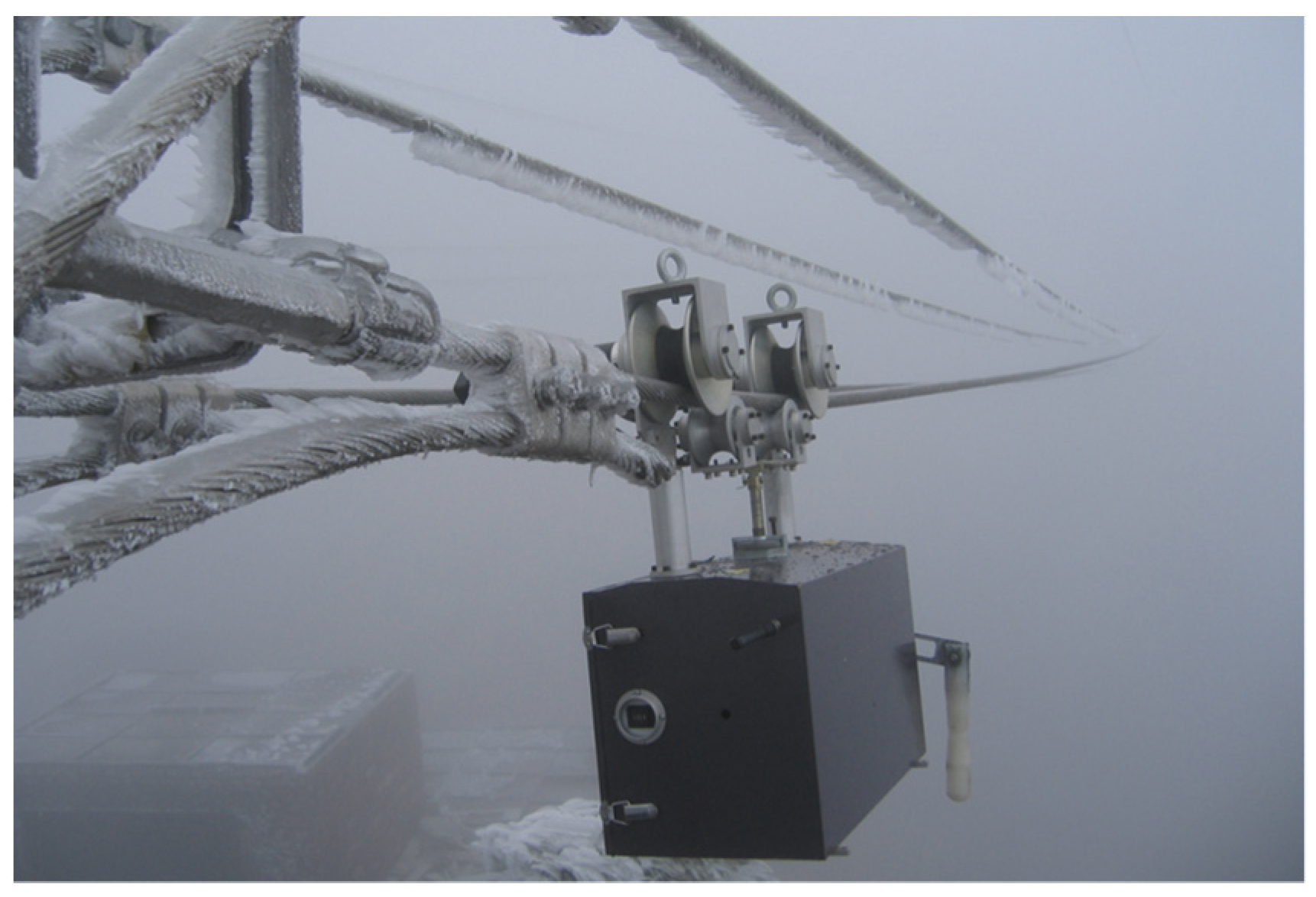
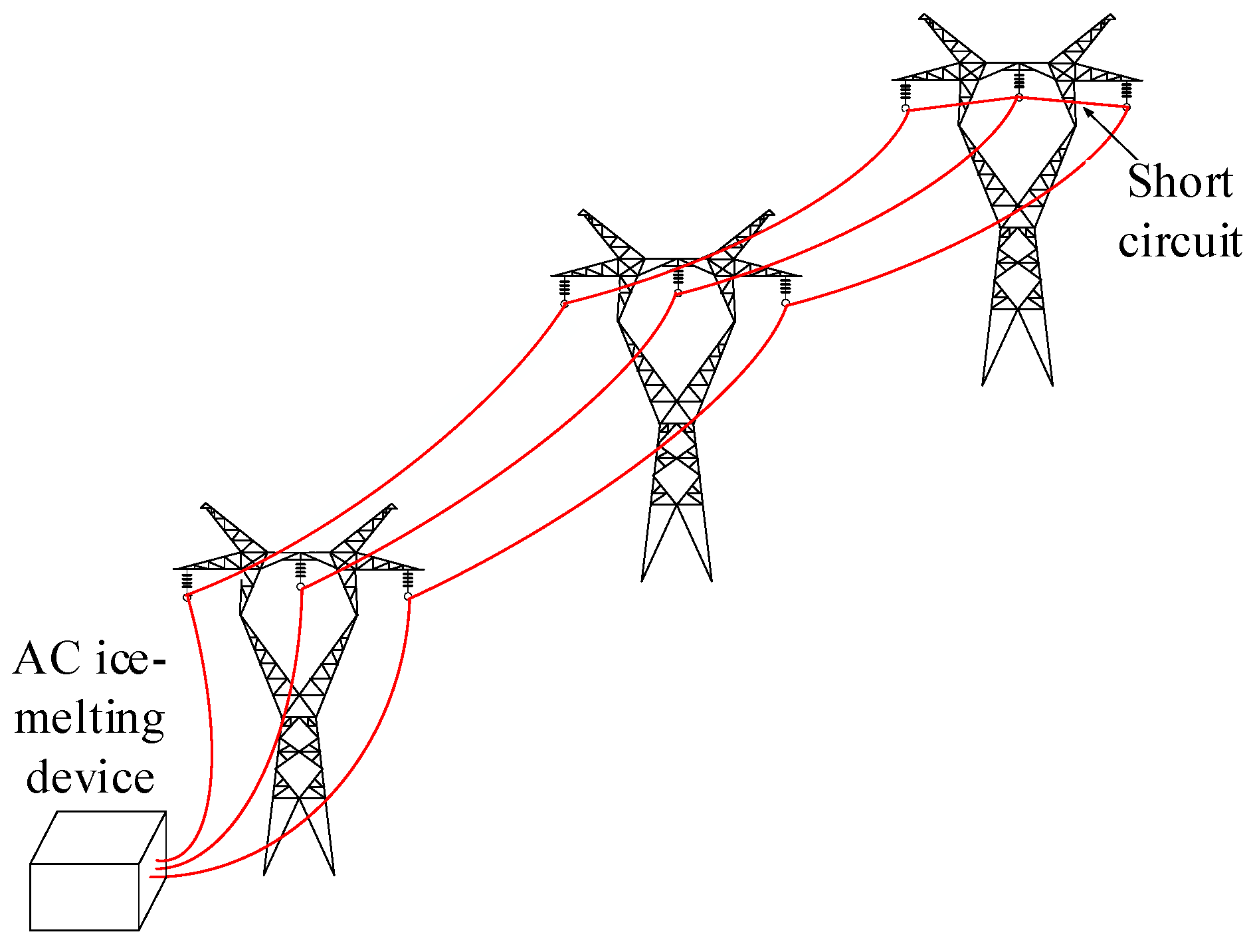



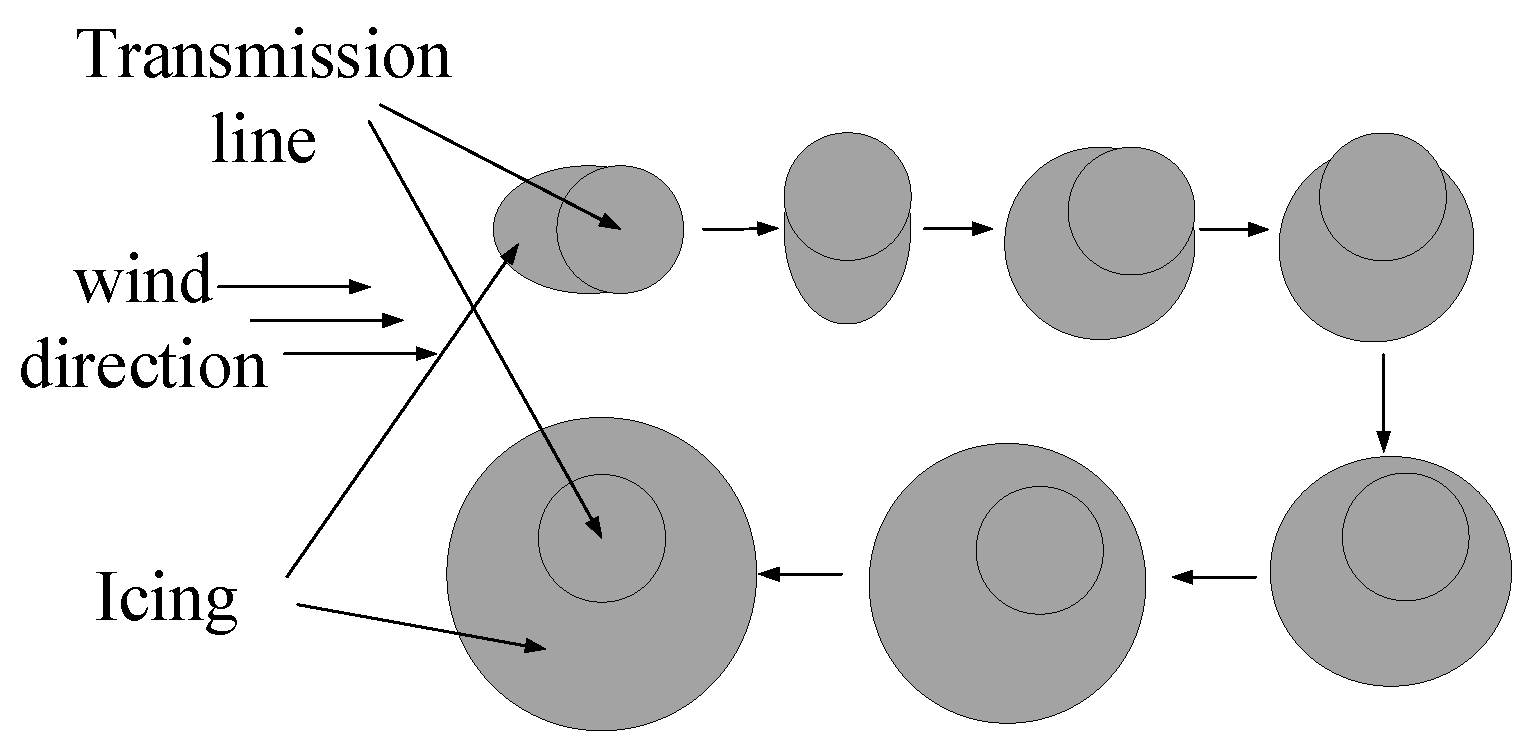



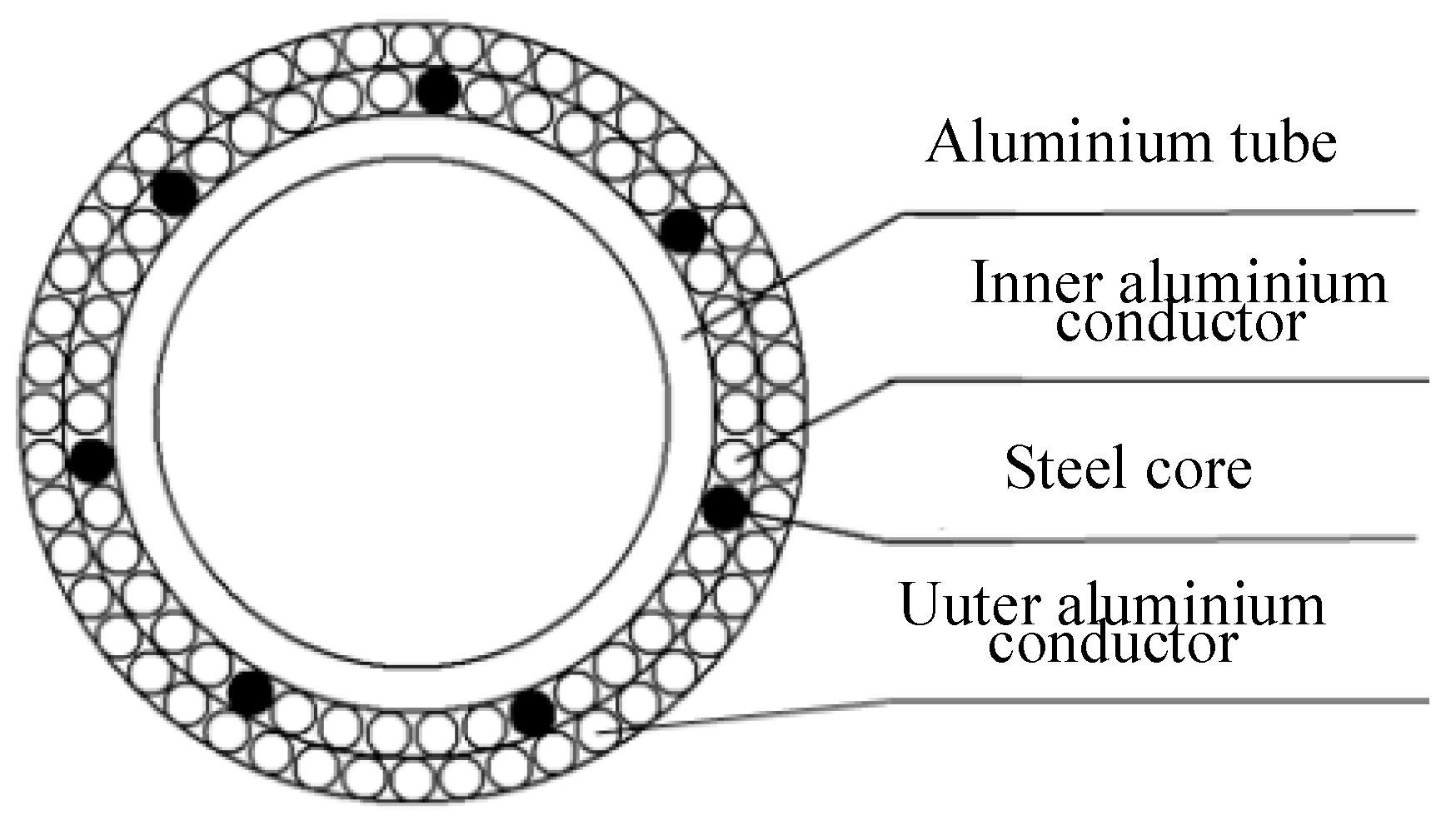


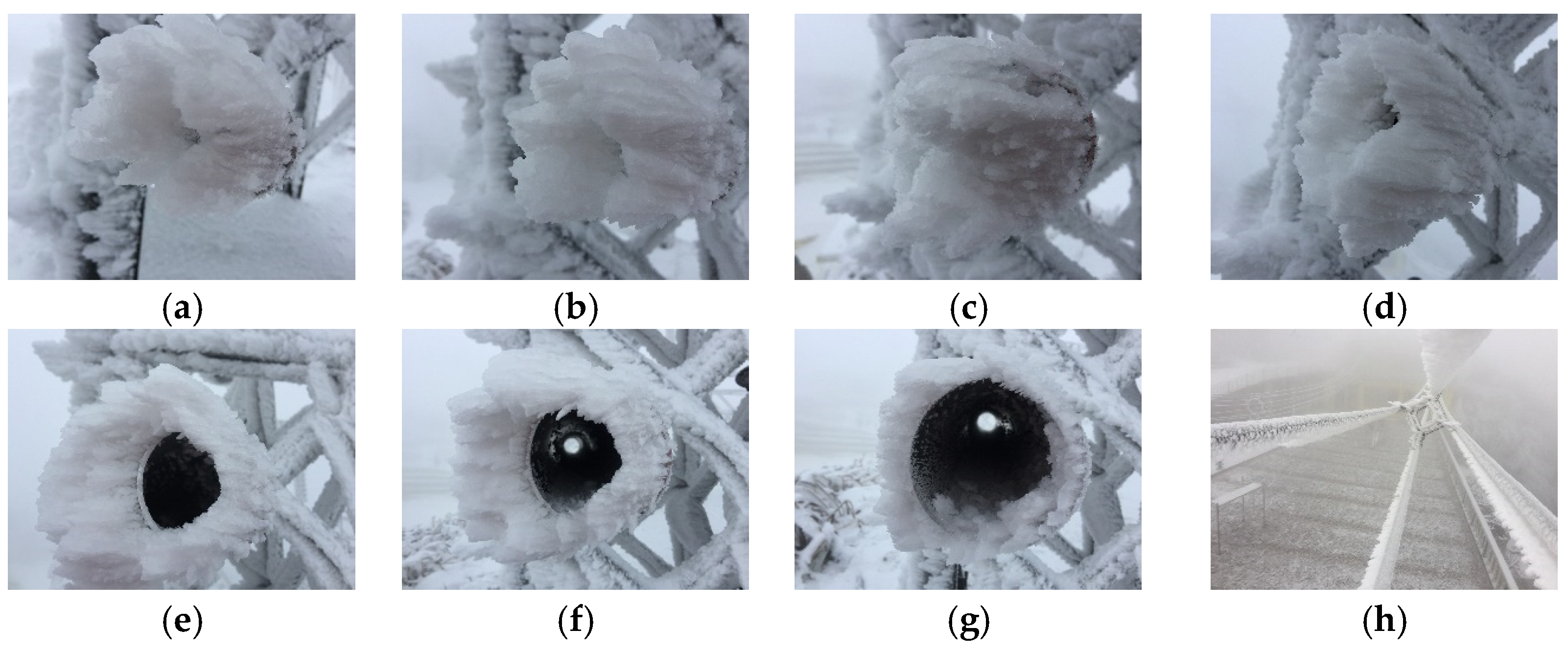



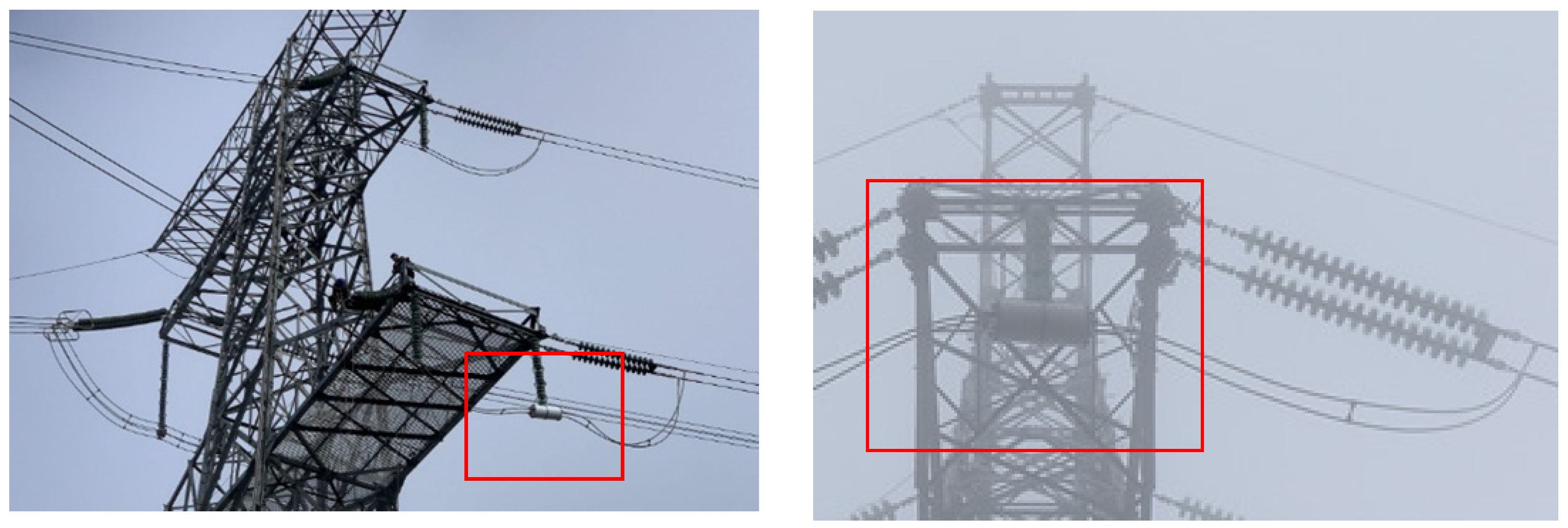


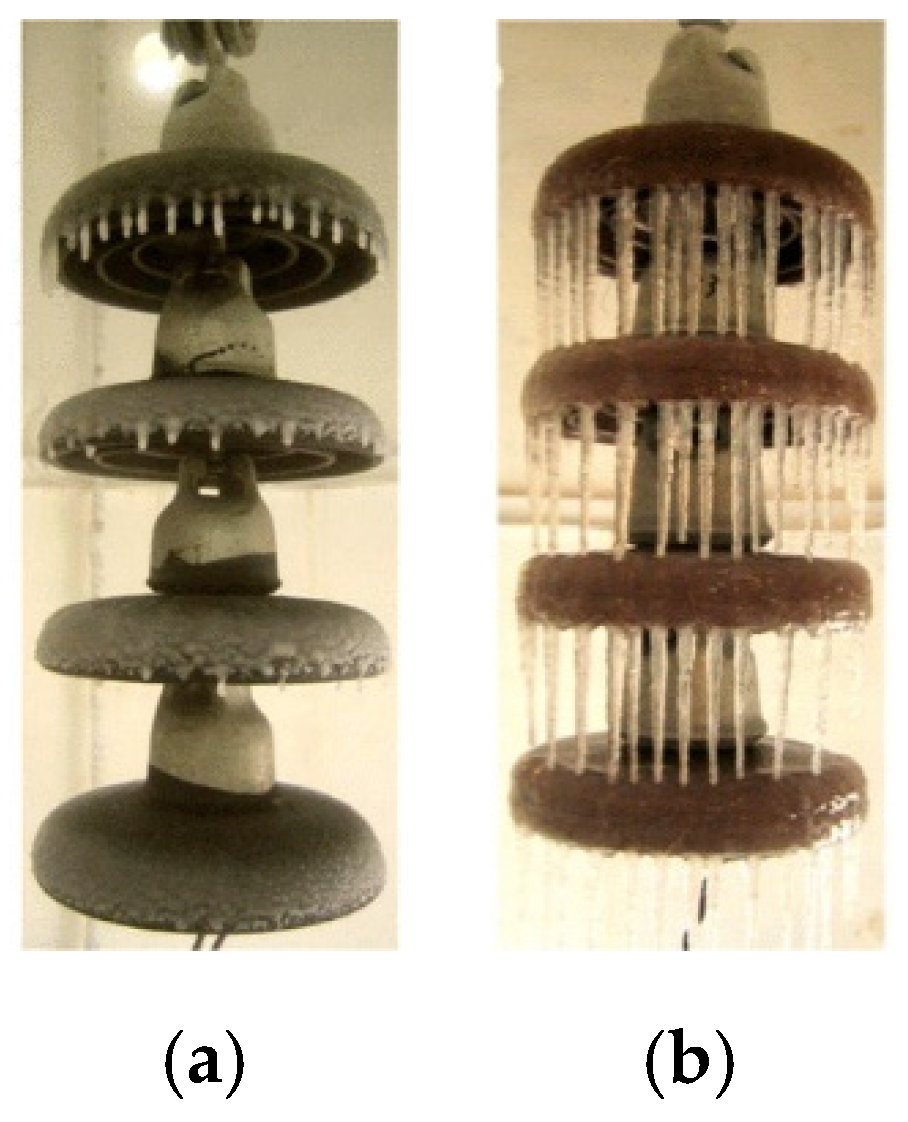

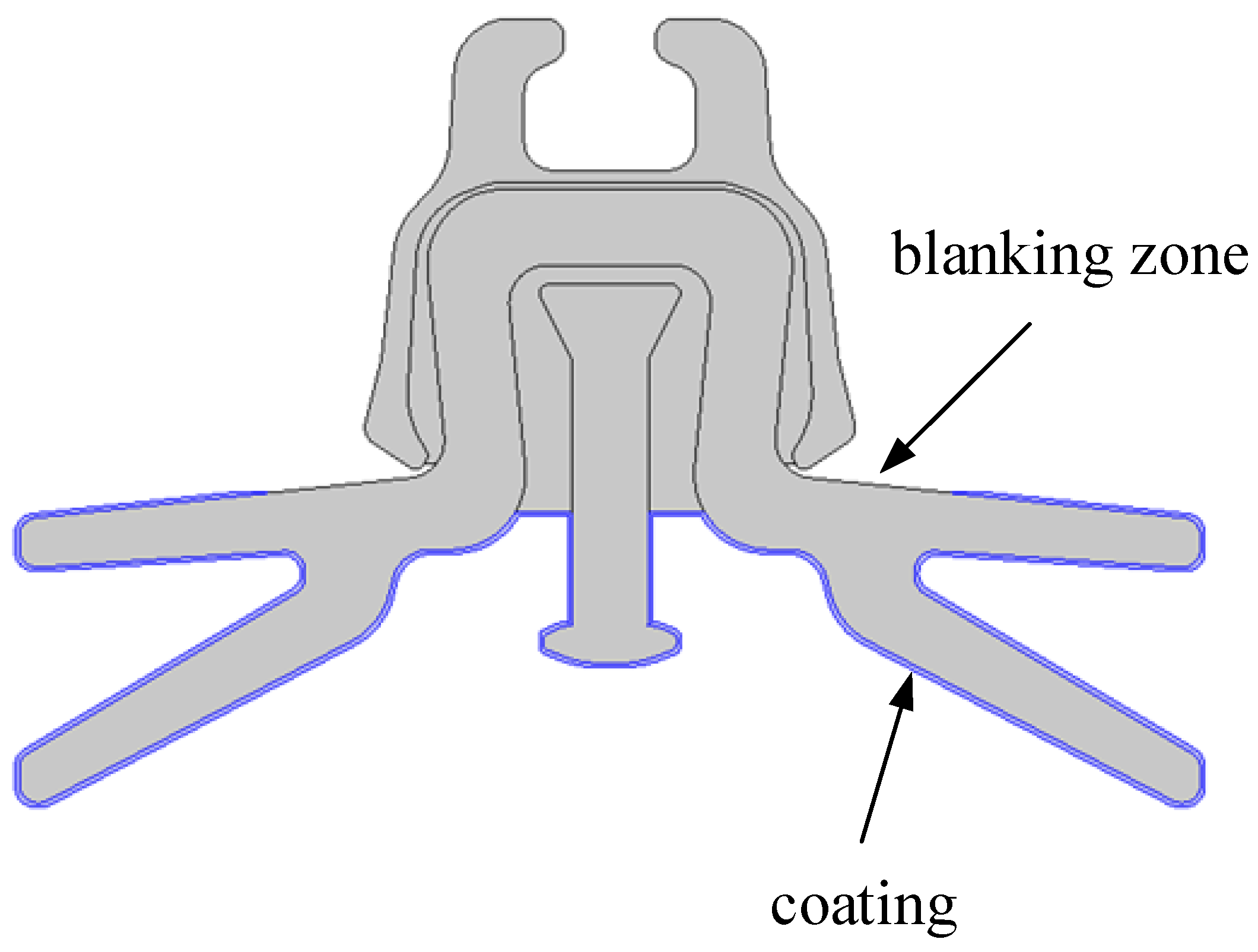

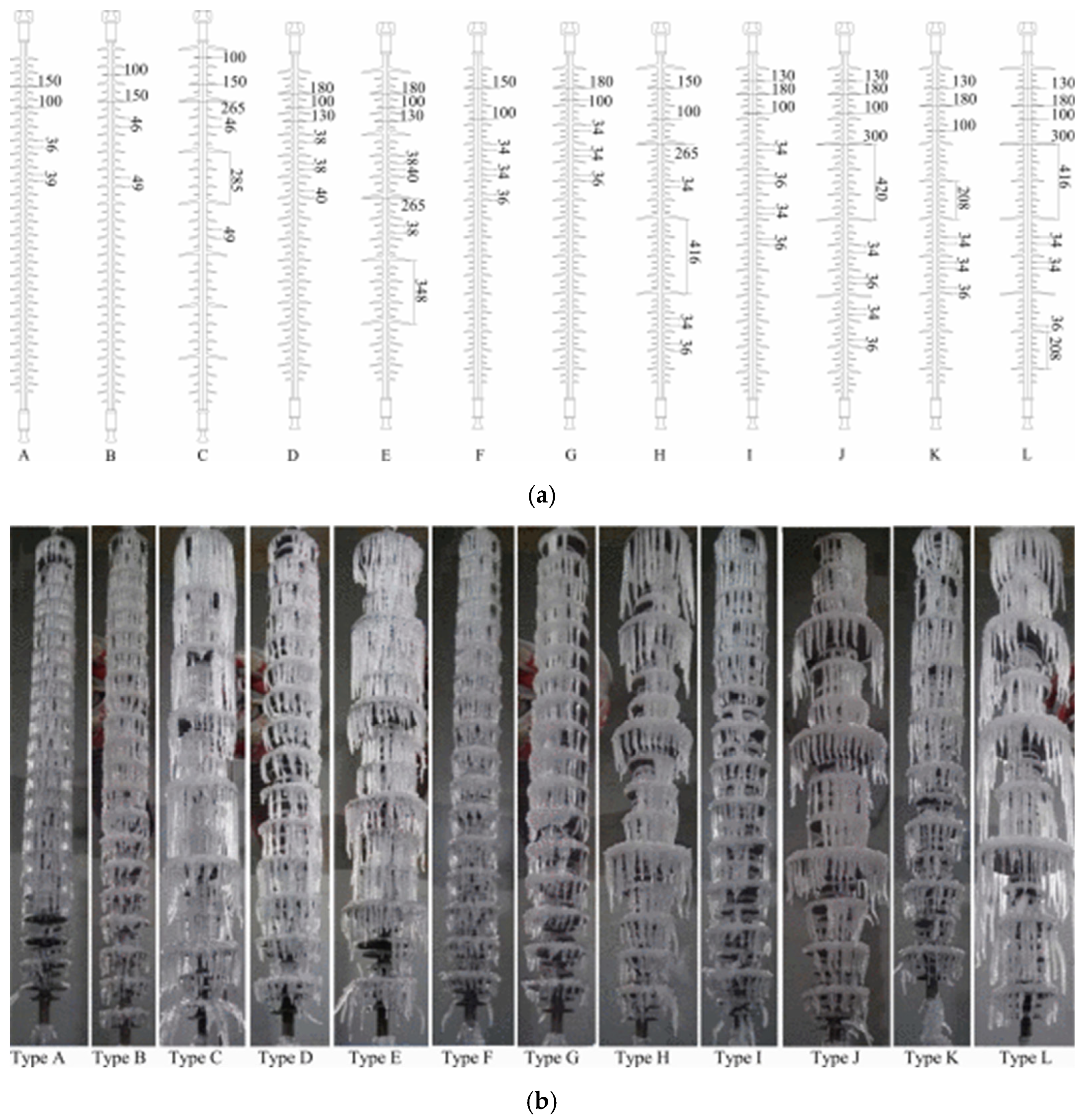
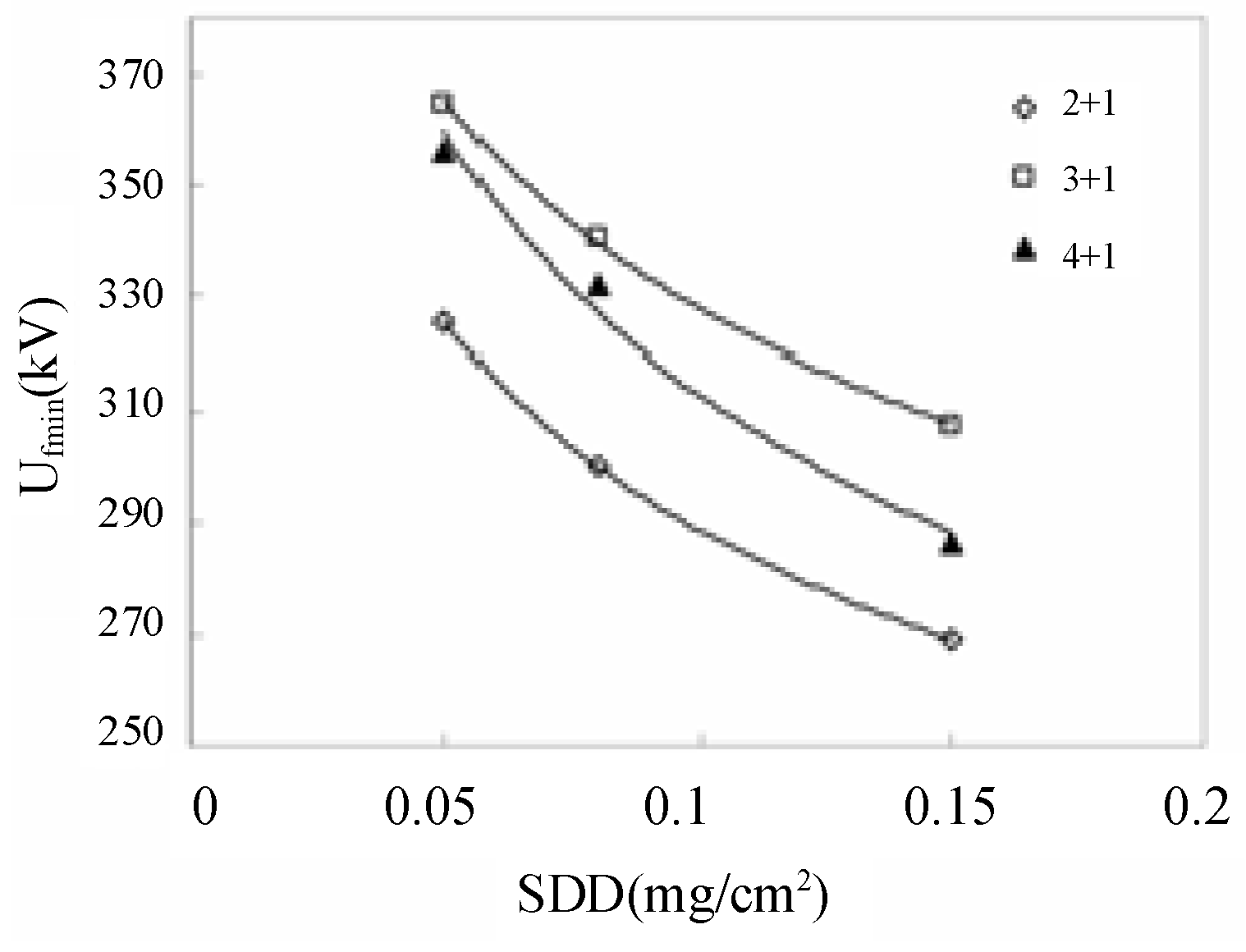

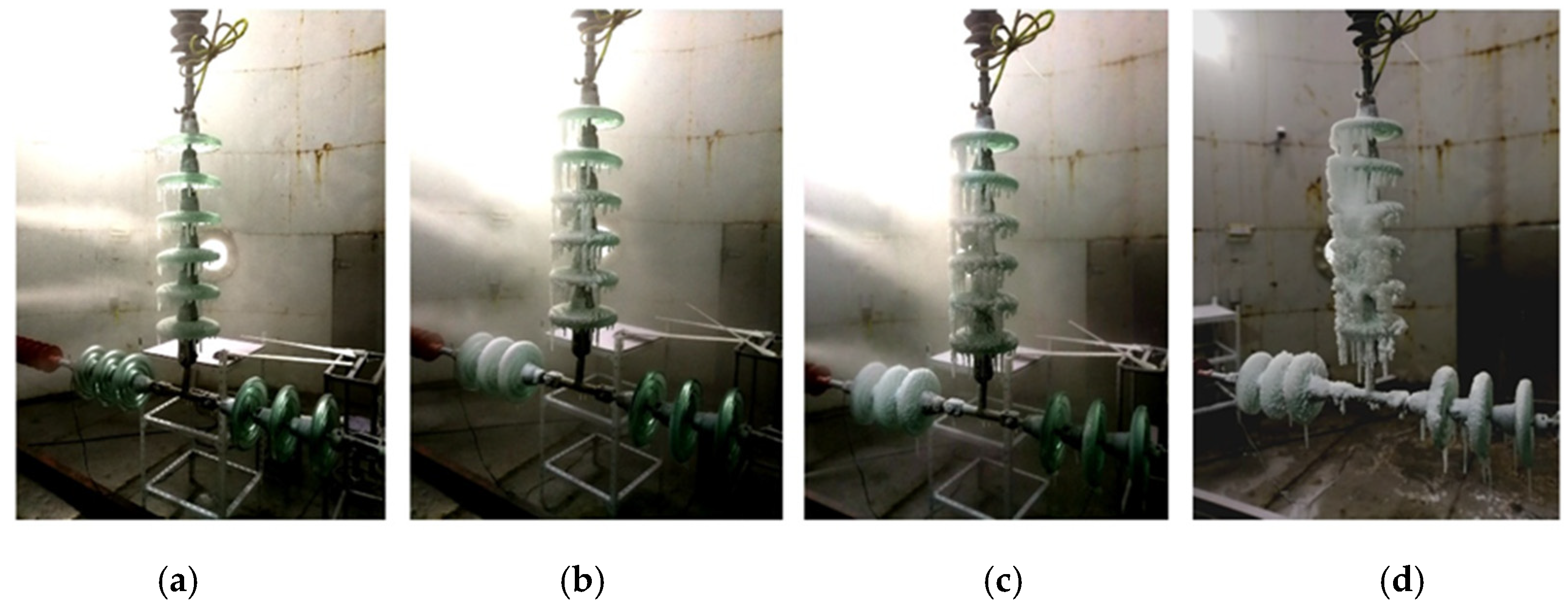

| Line Type | Line Parameters | DC Resistance (Ω/km) | Minimum Melting Current (A) | Effective Distance (km) | ||||
|---|---|---|---|---|---|---|---|---|
| Voltage Class (kV) | Conductor Type | 200 MW | 100 MW | 50 MW | 10 MW | |||
| DC | 800 | LGJ-6×630/45 | 0.0077 | 7075 | 258.8 | 129.4 | 64.7 | 12.9 |
| 500 | LGJ-4×720/50 | 0.0100 | 5254 | 363.7 | 181.9 | 90.9 | 18.2 | |
| AC | 500 | LGJ-4×500 | 0.0148 | 3979 | 427.4 | 213.7 | 106.8 | 21.4 |
| 200 | LGJ-2×500 | 0.0296 | 1989 | 854.8 | 427.4 | 213.7 | 42.7 | |
| 110 | LGJ-240 | 0.1198 | 609 | 2250.7 | 1125.3 | 562.7 | 112.5 | |
| 35 | LGJ-150 | 0.1962 | 441 | 2620.7 | 1310.4 | 655.2 | 131.0 | |
| Types | Advantages | Disadvantages |
|---|---|---|
| Stranded type | Production process is maturity, low cost | Poor structural stability, small diameter expansion |
| High-density polyethylene supported type | Large diameter expansion | Support core processing is complex, poor recovery after loose strands, high cost |
| Aluminum tube supported type | Metallic aluminum tubes made of conductive materials, need not add conductive material | The bending radius should be at least 20 times the diameter, difficult to construct, poor recovery after bending, high cost |
Disclaimer/Publisher’s Note: The statements, opinions and data contained in all publications are solely those of the individual author(s) and contributor(s) and not of MDPI and/or the editor(s). MDPI and/or the editor(s) disclaim responsibility for any injury to people or property resulting from any ideas, methods, instructions or products referred to in the content. |
© 2023 by the authors. Licensee MDPI, Basel, Switzerland. This article is an open access article distributed under the terms and conditions of the Creative Commons Attribution (CC BY) license (https://creativecommons.org/licenses/by/4.0/).
Share and Cite
Zhang, Z.; Zhang, H.; Yue, S.; Zeng, W. A Review of Icing and Anti-Icing Technology for Transmission Lines. Energies 2023, 16, 601. https://doi.org/10.3390/en16020601
Zhang Z, Zhang H, Yue S, Zeng W. A Review of Icing and Anti-Icing Technology for Transmission Lines. Energies. 2023; 16(2):601. https://doi.org/10.3390/en16020601
Chicago/Turabian StyleZhang, Zhijin, Hang Zhang, Song Yue, and Wenhui Zeng. 2023. "A Review of Icing and Anti-Icing Technology for Transmission Lines" Energies 16, no. 2: 601. https://doi.org/10.3390/en16020601
APA StyleZhang, Z., Zhang, H., Yue, S., & Zeng, W. (2023). A Review of Icing and Anti-Icing Technology for Transmission Lines. Energies, 16(2), 601. https://doi.org/10.3390/en16020601






